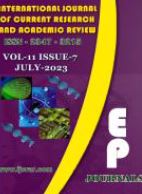Abstract Volume:11 Issue-7 Year-2023 Original Research Articles
 |
Online ISSN : 2347 - 3215 Issues : 12 per year Publisher : Excellent Publishers Email : editorijcret@gmail.com |
Heavy metals are metallic elements that have a high density and are toxic to living organisms at certain concentrations. They can enter agricultural soil through various sources, including industrial activities, mining operations, and the use of contaminated fertilizers and pesticides. These heavy metals, such as lead, cadmium, mercury, and arsenic, can have detrimental effects on agricultural soil, plant growth, and ultimately human health. One of the major impacts of heavy metals on agricultural soil is their accumulation over time. Continuous exposure to heavy metals can lead to their build-up in the soil, making it unsuitable for plant growth. This accumulation can disrupt the soil's physical and chemical properties, affecting its fertility and nutrient availability. Additionally, heavy metals can alter the soil's pH, leading to imbalances in nutrient uptake by plants. The presence of heavy metals in agricultural soil can significantly impact plant growth and development. These metals can inhibit seed germination, reduce root growth, and impair nutrient absorption in plants. They can also interfere with essential physiological processes, such as photosynthesis and enzyme activity, leading to stunted growth and reduced crop yields. Furthermore, heavy metals can be taken up by plants and accumulate in their tissues, posing a risk to human health when consumed. To mitigate the impacts of heavy metals on agricultural soil and plant growth, several strategies can be employed. The approach Heavy metals mitigation and remediation techniques encompass a range of approaches, including soil stabilization, soil washing, phytoremediation, bioremediation, electrokinetic remediation, and thermal desorption. Soil stabilization involves the addition of amendments to immobilize heavy metals, reducing their mobility and bioavailability. Soil washing employs chemical solutions or water to remove heavy metals from contaminated soil. These plants, known as hyperaccumulators, can be used to extract heavy metals from contaminated soil, thereby reducing their concentration. Additionally, proper waste management and the use of organic fertilizers can help minimize heavy metal contamination in agricultural soil.
How to cite this article:
Gebreslassie Hailu. 2023. Heavy Metals Sources and Impacts on Agricultural Soil, Plant Growth and MitigationsInt.J.Curr.Res.Aca.Rev. 11(7): 27-34doi: https://doi.org/10.20546/ijcrar.2023.1107.004



Quick Navigation
- Print Article
- Full Text PDF
- How to Cite this Article
- on Google
- on Google Scholor
- Citation Alert By Google Scholar
